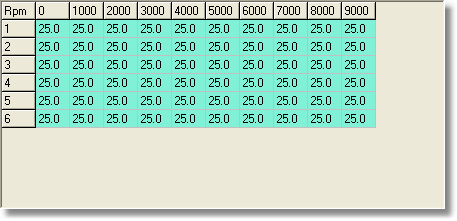These boost control parameters determine how the ECU controls the boost control solenoid. For CAN Boost parameters see here.
Duty Cycle
To control the solenoid a square wave is sent to the solenoid. Due to the impedance of the solenoid and frequency of the output this square wave results in a progressive opening (or closing) of the solenoid The solenoid will have an effective range, outside which changing the duty cycle will not affect the solenoid opening. For most solenoids this is 15% to 85% duty cycle, so it not recommended to operate the solenoid outside these limits. When the settings are configured for a normally open solenoid the actual duty cycle is inverted so that a higher duty cycle will increase boost.
Enabling Boost Control
![]()
The enables the boost control output on ECU pin B2 (Civic Si) or B16 (S2000).
Solenoid Configuration
![]()
There are two types of solenoid - normally open and normally closed. A normally open solenoid (like a GM solenoid) will give maximum boost at 0% duty. Note that in this case FlashProManager inverts the duty cycle so that in FlashProManager 0% duty cycle is minimum boost, and 100% duty cycle is maximum boost. It is important to set a boost limit as a solenoid or wiring failure will result in maximum boost. A normally closed solenoid will give maximum boost at 100% duty.
Activation Pressure
![]()
Since you do not need the boost control solenoid running all the time, the solenoid will activate above a certain manifold pressure. It is best to set this pressure slightly over atmospheric pressure.
Frequency
The frequency of the solenoid control output waveform can be set from 10 - 100 Hz. This will affect the boost level and the maximum amount of boost which the boost controller can generate.
![]()
Most solenoids operate best from 10-60 Hz.
Control Method
There are two methods for determining the boost control solenoid duty cycle - fixed duty cycle and duty cycle by rpm and gear.
![]()
Fixed duty cycle
![]()
This setting will output a fixed duty cycle to the solenoid once the solenoid activation pressure is reached, and should give a fairly flat boost curve which is the same in each gear.
Duty cycle by Rpm & Gear

These tables set the duty cycle for each gear and rpm. This allows you to increase boost in higher gears as traction permits. Note that these tables can also be used to set boost by speed and gear since speed is related to rpm and gear.
Air Temperature Compensation

The boost pressure for a given duty cycle will vary with ambient air temperature, with increased pressure with cooler air and less pressure with hotter air. This table allows you to adjust the duty cycle based on intake air temperature. The compensation is applied to both a fixed duty cycle and duty cycle by rpm & gear.
Quick Spool

This tables opens up the boost control solenoid completely and closes the waste gate to build up boost faster. Once the pressure reaches the value in the table the solenoid goes back to its normal duty cycle. When using this feature, we recommend setting the solenoid activation pressure to 1 pound of boost, and the quick spool pressures to 1 or 2 pounds below target boost levels. To disable quick spool, set the values in the table lower than the solenoid activation pressure.